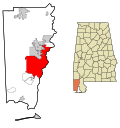History
Oakleigh was built on 33 acres (130,000 m2) of woodland west of Mobile in 1833 by James W. Roper, a brick mason from James City County, Virginia who was also a dry goods merchant and cotton factor. He chose this site for his house because of its valuable clay pit. He operated a Water Street brickyard in downtown Mobile on the present-day site of the RSA Battle House Tower.
While building Oakleigh, Roper lost his first wife, Sarah Ann Davenport, and a child. He remarried in 1838 upon completion of Oakleigh, and had four children with his second wife, Eliza Ann Simison. [1]
The Panic of 1837 hit Roper and his business interests hard. After borrowing $20,000 to build the home, he was unable to pay back his loans, and the bank repossessed the home. With his business interests failing, Roper and his family then left Mobile, and became a lumber merchant in New Orleans, Louisiana in 1840. The bank would then sell off 24 acres of the land and rent out the home. [1]
Alfred Irwin, treasurer of the Mobile & Ohio Railroad, purchased the house in 1852. During the Civil War his wife, Margaret Kilshaw Irwin, defended the home against Union soldiers by proclaiming the property neutral territory on account of her British citizenship and hanging the Union Jack from the balcony. T.K. and Lee Fearn Irwin, their sons, were both veterans of the Civil War and gained local prominence in the late 19th century. Lee served as Mobile's assistant postmaster, president of the Cherokee Cotton Mills, and manager of the Mobile Oil Mills. His older brother T.K., once aide to Confederate president Jefferson Davis, went on to establish the Mobile Cotton Exchange and later became its president. T.K. married Mary Anna Ketchum. Much of their correspondence from the Civil War years and after remains on file at Oakleigh today. Oakleigh remained in the Irwin family until sold by Daisy Irwin Clisby, granddaughter of Alfred, in 1916. [1]
This page is based on this
Wikipedia article Text is available under the
CC BY-SA 4.0 license; additional terms may apply.
Images, videos and audio are available under their respective licenses.





